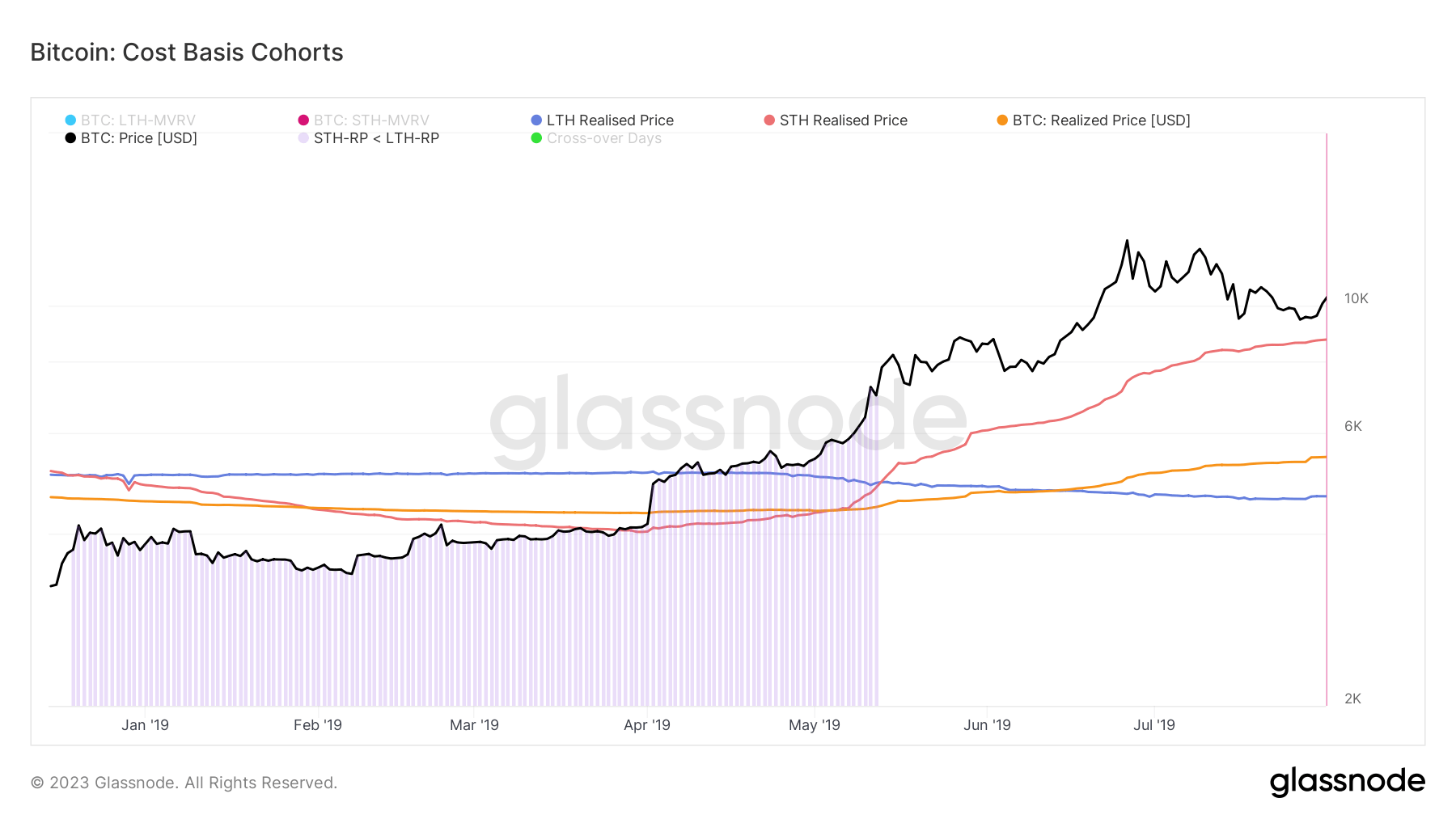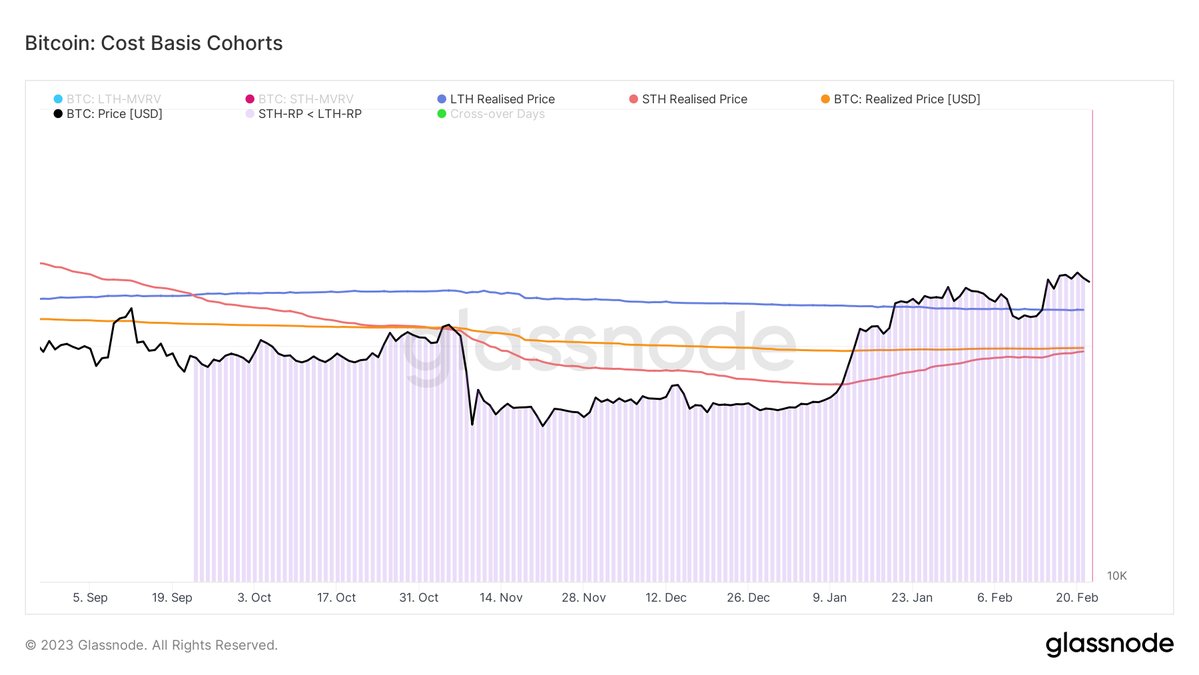The on-chain metric that could signal a bear market reversal

Realized price is a metric often used to determine market movements in bear and bull markets. Defined as the value of all Bitcoins at the price they were bought divided by the number of circulating coins, realized price effectively shows the cost-basis of the network.
Dividing the network into cohorts can help us reflect the aggregate cost basis for each major group owning Bitcoin. Long-term holders (LTHs) and short-term holders (STHs) are the two primary cohorts driving the market — LTHs are all addresses that held BTC for longer than 155 days, while STHs are addresses that held onto BTC for less than 155 days.
The LTH-STH cost basis ratio is the ratio between the realized price for long-term and short-term holders. Given the historically different behaviors LTHs and STHs exhibit, the ratio between their realized prices can illustrate how the market dynamic is shifting.
For example, an uptrend in the LTH-STH cost basis ratio is seen when STHs realize more losses than LTHs. This shows that short-term holders are selling their BTC to LTHs, indicating a bear market accumulation phase led by LTHs.
A downtrend in the ratio shows that LTHs are spending their coins faster than STHs. This indicates a bull market distribution phase, where LTHs sell their BTC for profit, which STHs buy up.
An LTH-STH cost basis ratio higher than 1 indicates that the cost basis for LTHs is higher than the cost basis for STHs. This has historically correlated with late-stage bear market capitulations that turned into bull runs.

2011
During Bitcoin’s first bear market in 2011, the STH realized price went below the LTH realized price. This trend reversal marked the beginning of a bear market which started on Nov. 22, 2011 and lasted until Jul. 17, 2012.
Long-term holders accumulated BTC throughout the bear market, dollar-cost averaging (DCA) and bringing their cost-basis down. Buying during suppressed prices created a new influx of short-term holders that pushed Bitcoin’s price up. This increase in STH accumulation caused the STH realized price to rise, increasing the overall cost-basis of the network with it.

2015
The 2015 bear market followed a similar pattern. On Jan. 8, 2015, the STH realized price dropped below the LTH realized price, triggering a bear market that lasted until Dec. 08, 2015.
While Bitcoin’s price began recovering in early November 2015, it wasn’t until the beginning of December that the STH realized price broke above the LTH realized price. At the time, the overall cost basis of the network increased slightly, triggering a bear market reversal that saw Bitcoin’s price go past $400.

2018
Bitcoin’s coveted rally to $20,000 in late 2018 ended when the STH realized price declined. It dropped below the LTH realized price on Dec. 20, 2018, pushing Bitcoin’s spot price way below its realized price.
The bear market ended on May 13, 2019, when the STH realized price bounced back above the LTH realized price.

2022
The STH realized price began descending at the beginning of September 2022, dripping below the LTH realized price on Sept. 22, 2022. It continued downward until Jan. 10, 2023, when it began a slow and steady rebound that almost brought it on par with Bitcoin’s realized price.
The STH realized price currently stands at $19,671, while the LTH realized price is $22,228. Bitcoin’s realized price is $19,876.

Data analyzed by CryptoSlate showed that 4-year cycles in the Bitcoin market end when the STH realized price flips both Bitcoin’s realized price and the LTH realized price. This creates a measurable market FOMO that triggers a parabolic run.
This flippening happened in 2011 after 9 months in a bear market, in 2015 after 11 months, and in 2019 after 6 months. It’s been 5 months since the STH realized price dropped below the LTH realized price in 2022.






 Bitcoin
Bitcoin  Ethereum
Ethereum  Tether
Tether  USDC
USDC  TRON
TRON  Dogecoin
Dogecoin  Cardano
Cardano  Stellar
Stellar  Bitcoin Cash
Bitcoin Cash  Chainlink
Chainlink  Hedera
Hedera  Litecoin
Litecoin  LEO Token
LEO Token  Monero
Monero  Cronos
Cronos  Dai
Dai  Ethereum Classic
Ethereum Classic  OKB
OKB  Algorand
Algorand  VeChain
VeChain  Gate
Gate  Cosmos Hub
Cosmos Hub  KuCoin
KuCoin  Stacks
Stacks  Tether Gold
Tether Gold  Tezos
Tezos  Theta Network
Theta Network  IOTA
IOTA  Zcash
Zcash  TrueUSD
TrueUSD  NEO
NEO  Polygon
Polygon  Decred
Decred  Dash
Dash  Basic Attention
Basic Attention  Qtum
Qtum  Zilliqa
Zilliqa  Ravencoin
Ravencoin  0x Protocol
0x Protocol  Synthetix Network
Synthetix Network  Siacoin
Siacoin  Holo
Holo  DigiByte
DigiByte  Enjin Coin
Enjin Coin  Ontology
Ontology  Nano
Nano  Status
Status  Hive
Hive  Waves
Waves  Lisk
Lisk  Steem
Steem  Pax Dollar
Pax Dollar  Numeraire
Numeraire  BUSD
BUSD  Huobi
Huobi  NEM
NEM  OMG Network
OMG Network  Bitcoin Gold
Bitcoin Gold  Ren
Ren  Bitcoin Diamond
Bitcoin Diamond